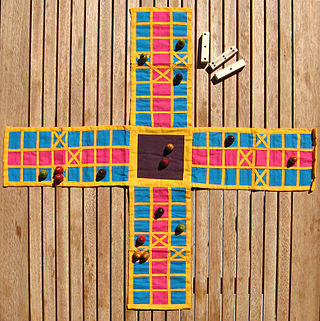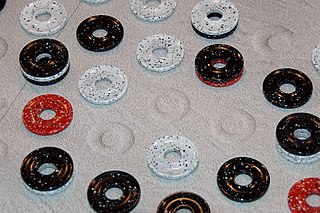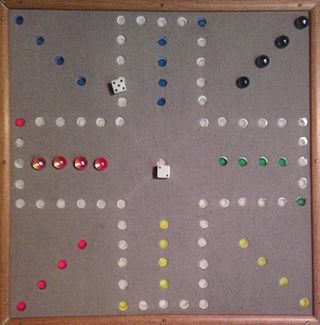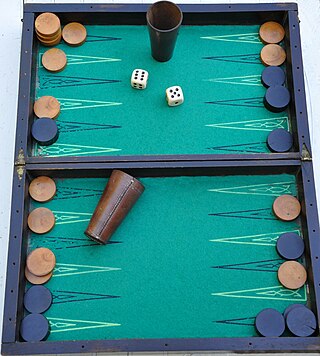
Ludo is a strategy board game for two to four players, in which the players race their four tokens from start to finish according to the rolls of a single die. Like other cross and circle games, Ludo is derived from the Indian game Pachisi. The game and its variations are popular in many countries and under various names.

Pachisi is a cross and circle board game that originated in Ancient India. It is described in the ancient text Mahabharata under the name of "Pasha". It is played on a board shaped like a symmetrical cross. A player's pieces move around the board based upon a throw of six or seven cowrie shells, with the number of shells resting with the aperture upward indicating the number of spaces to move.

Trouble is a board game in which players compete to be the first to send four pieces all the way around a board. Pieces are moved according to the roll of a die using a contained device called a "Pop-O-Matic".

Parqués is the Colombian version of a board game in the cross and circle family. The game is described as a "random thinking" game: the moves depend on the roll of the dice but players must consider possible strategies before executing their move. The objective of the game is to advance all the pieces to the end. Once in the safety zone player can use 2 dice until they are one space away from home, where they will then just use one die.

Parcheesi is a brand-name American adaptation of the Indian cross and circle board game Pachisi, published by Selchow & Righter and Winning Moves Games USA.

DVONN is a two-player strategy board game in which the objective is to accumulate pieces in stacks. It was released in 2001 by Kris Burm as the fourth game in the GIPF Project. DVONN won the 2002 International Gamers Award and the Games magazine Game of the Year Award in 2003.

GIPF is an abstract strategy board game by Kris Burm, the first of seven games in his series of games called the GIPF Project. GIPF was recommended by Spiel des Jahres in 1998.

Nard is an historical Persian tables game for two players that is sometimes considered ancestral to backgammon. It is still played today, albeit in a different form. As in other tables games, the playing pieces are moved around a board according to rolls of dice. It uses a standard tables board, but has a different opening layout and rules of play from that of backgammon.
Lotus is a board game for two to four players, developed by Dominique Tellier and published by Ravensburger Spieleverlag. The objective of the game is to move one's pieces off the board before the other players. The game board is hexagonal, and contains a large image of a Chinese dragon in the middle, as well as a Chinese character in each board position.

Crosstrack, billed as the "unique track switching game", is an abstract strategy game designed by Philip Shoptaugh and first published in 1994. Players place special track pieces onto an irregular octagon board, winning by being the first to create an unbroken path between two opposite sides. It is an example of a tile-based edge-matching path connection game, similar to the Black Path Game, Trax, and Tsuro, Tantrix and Kaliko, and Octiles.

Aeroplane chess is a Chinese cross-and-circle board game similar to the Western game of Ludo and the Indian game of Pachisi. Developed in the 20th century, aeroplane chess features airplanes as pieces instead of the more abstract pawns and beehive-shaped pieces found in the games from which it is derived. Aeroplane chess has spread around the world, especially in Africa.

Aggravation is a board game for up to four players and later versions for up to six players, whose object is to be the first player to have all four playing pieces reach the player's home section of the board. The game's name comes from the action of capturing an opponent's piece by landing on its space, which is known as "aggravating". The name was coined by one of the creators, Lois Elaine, who did not always enjoy defeat.

TZAAR is the seventh game released in the GIPF series and Games Magazine's 2009 Game of the Year. It officially replaced TAMSK, which was originally published as the second board game in the GIPF Project.
Rimau-rimau is a two-player abstract strategy board game that belongs to the hunt game family. This family includes games like Bagh-Chal, Main Tapal Empat, Aadu puli attam, Catch the Hare, Sua Ghin Gnua, the Fox games, Buga-shadara, and many more. Rimau-rimau is the plural of rimau which is an abbreviation of the word harimau, meaning 'tiger' in the Malay language. Therefore, rimau-rimau means 'tigers'. The several hunters attempting to surround and immobilize the tigers are called orang-orang, which is the plural of orang, meaning 'man'. Therefore, orang-orang means 'men' and there are twenty-two or twenty-four of them, depending on which version of the game is played. The game originates from Malaysia.
Kolowis Awithlaknannai is a two-player strategy board game from the Zuni Native American Indians. It was described by Stewart Culin in his book Games of the North American Indians (1907), and may have been the first publication of the game. It was later described in R.C. Bell's book Board and Table Games from Many Civilizations (1969). R.C. Bell coined the term Fighting Serpents, but provides no explanation for it. Perhaps the black and white pieces are laid out in the beginning of the game in such a way that it looks like two serpents fighting.

Dayakattai or Dayaboss is a Tamil dice game played by 2 or 4 people by forming teams. It originated in Tamil Nadu and is comparable to another dice game from the country called Pachisi. Dayakattai takes many different forms.
This glossary of board games explains commonly used terms in board games, in alphabetical order. For a list of board games, see List of board games; for terms specific to chess, see Glossary of chess; for terms specific to chess problems, see Glossary of chess problems.
Hexagony is an abstract strategy board game for 2 to 6 players that was published as Bin'Fa by Taoist Arts Inc. in 1977, as Hexagony by Avalon Hill in 1980, and later re-released in a slightly modified form by Kenterprises as Bin'Fa.

The following is a glossary of terms used in tables games, essentially games played on a Backgammon-type board. Terms in this glossary should not be game-specific, but applicable to a range of tables games.















